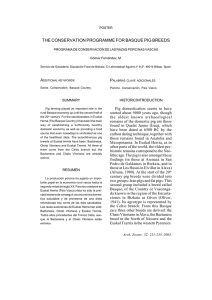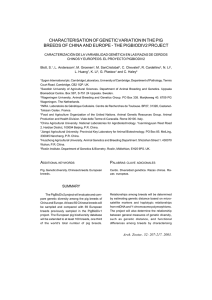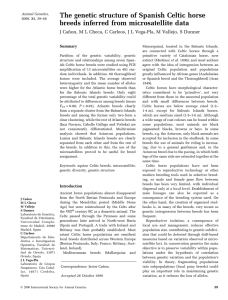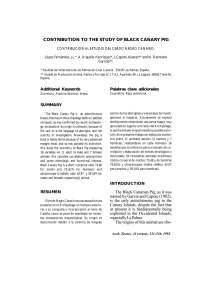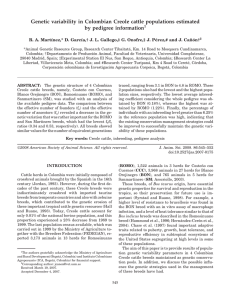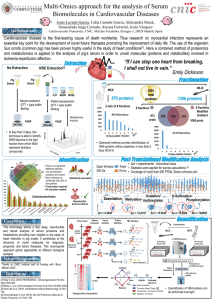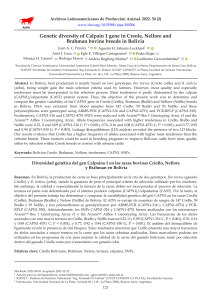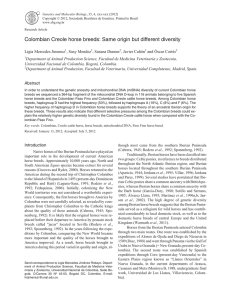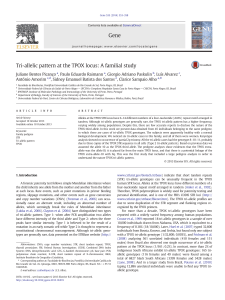use of type i dna markers for initial genetic
Anuncio
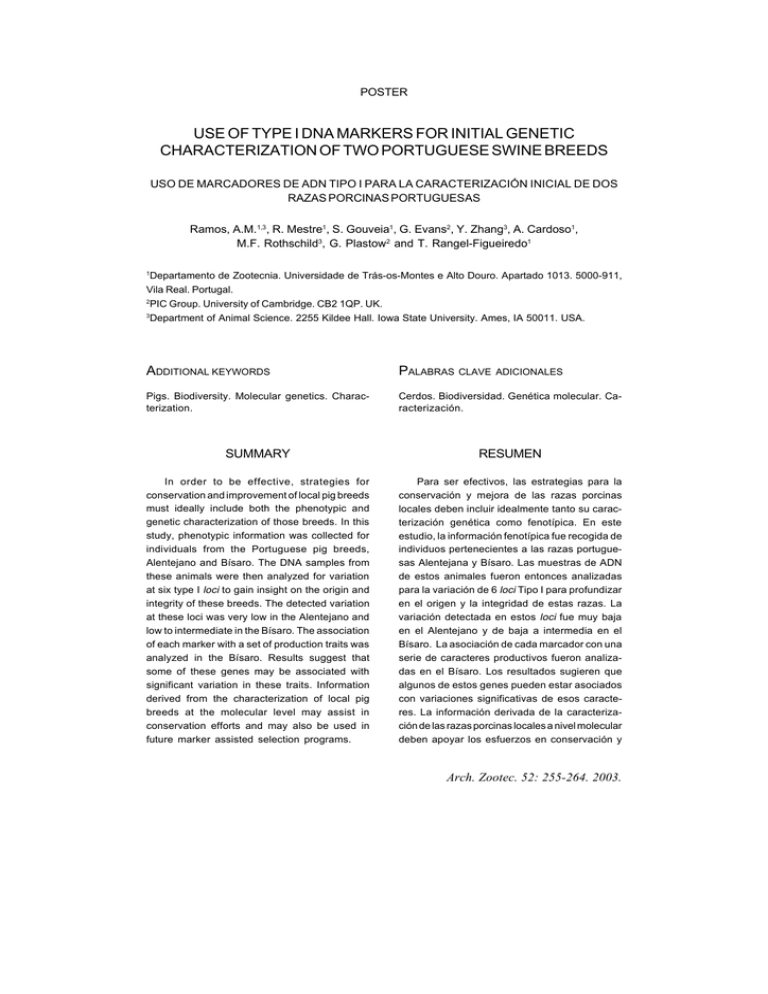
POSTER USE OF TYPE I DNA MARKERS FOR INITIAL GENETIC CHARACTERIZATION OF TWO PORTUGUESE SWINE BREEDS USO DE MARCADORES DE ADN TIPO I PARA LA CARACTERIZACIÓN INICIAL DE DOS RAZAS PORCINAS PORTUGUESAS Ramos, A.M.1,3, R. Mestre1, S. Gouveia1, G. Evans2, Y. Zhang3, A. Cardoso1, M.F. Rothschild3, G. Plastow2 and T. Rangel-Figueiredo1 1 Departamento de Zootecnia. Universidade de Trás-os-Montes e Alto Douro. Apartado 1013. 5000-911, Vila Real. Portugal. 2 PIC Group. University of Cambridge. CB2 1QP. UK. 3 Department of Animal Science. 2255 Kildee Hall. Iowa State University. Ames, IA 50011. USA. ADDITIONAL KEYWORDS PALABRAS CLAVE Pigs. Biodiversity. Molecular genetics. Characterization. Cerdos. Biodiversidad. Genética molecular. Caracterización. SUMMARY RESUMEN In order to be effective, strategies for conservation and improvement of local pig breeds must ideally include both the phenotypic and genetic characterization of those breeds. In this study, phenotypic information was collected for individuals from the Portuguese pig breeds, Alentejano and Bísaro. The DNA samples from these animals were then analyzed for variation at six type I loci to gain insight on the origin and integrity of these breeds. The detected variation at these loci was very low in the Alentejano and low to intermediate in the Bísaro. The association of each marker with a set of production traits was analyzed in the Bísaro. Results suggest that some of these genes may be associated with significant variation in these traits. Information derived from the characterization of local pig breeds at the molecular level may assist in conservation efforts and may also be used in future marker assisted selection programs. Para ser efectivos, las estrategias para la conservación y mejora de las razas porcinas locales deben incluir idealmente tanto su caracterización genética como fenotípica. En este estudio, la información fenotípica fue recogida de individuos pertenecientes a las razas portuguesas Alentejana y Bísaro. Las muestras de ADN de estos animales fueron entonces analizadas para la variación de 6 loci Tipo I para profundizar en el origen y la integridad de estas razas. La variación detectada en estos loci fue muy baja en el Alentejano y de baja a intermedia en el Bísaro. La asociación de cada marcador con una serie de caracteres productivos fueron analizadas en el Bísaro. Los resultados sugieren que algunos de estos genes pueden estar asociados con variaciones significativas de esos caracteres. La información derivada de la caracterización de las razas porcinas locales a nivel molecular deben apoyar los esfuerzos en conservación y ADICIONALES Arch. Zootec. 52: 255-264. 2003. RAMOS ET AL. deben también ser utilizadas en el futuro en programas de selección asistida por marcadores. INTRODUCTION Pig meat is a major source of protein for humans, accounting for approximately 43 percent of the world production of meat, according to the Food and Agriculture Organization of the United Nations (FAO) statistics. A relatively small number of breeds are used in intensive pig production. This has led to an important decrease in registered numbers of animals from local breeds, as these are frequently replaced by improved breeds developed by mass selection in large breeding programs and typically characterized by higher or more efficient production levels. However, local pig breeds carry unique characteristics including for example adaptations to particular production systems and environmental conditions. Furthermore, these breeds still represent the majority of the porcine population in several regions of the world. Nearly 46 percent of the world swine breeds are found in Europe. However, a large number of these breeds face the risk of extinction (FAO, 2000). The disappearance of these breeds would be an irreplaceable loss of a unique genetic heritage. The preservation of these local genotypes is essential to guarantee the genetic variability contained in these breeds for future generations. Such genetic variability may also increase in importance as changes occur in consumer demands, production systems and the environment. In addition to the conservation efforts, there is also the need to characterize local porcine breeds at the morphological, genetic and production levels, improve its performance and increase the value of the breeds' typical products, by creating protected quality marks. For this purpose, sound and efficient breeding programs are needed, where DNA marker information may assist in the selection of quantitative traits, including those that can be selected by traditional means. There are two Portuguese indigenous pig breeds, the Bísaro, located in the northeast part of the country, and the Alentejano, reared in the southern regions of Portugal. The census for the Bísaro breed is presently of 850 adult individuals, while in the Alentejano 6000 animals are registered in the herd book. According to the criteria established by the FAO, the Bísaro is an endangered– maintained breed, while the Alentejano is not at risk. The Bísaro is a Celtic type breed, considered to have originated from the European wild pig. The breed has been submitted to crossbreeding, with some British breeds, such as Berkshire, Large Black and Large White, in the first decades of the 20th century (Vale, 1949) and also with Large White and Pietrain in the last 30 years. Active crossbreeding was eliminated only in 1994, after the establishment of the Breeders Association and the herd book. The Bísaro is usually bred in small family herds, of no more than 10 pigs per farm, although recently some larger farms have also appeared. The Alentejano is a Mediterranean type breed, related to the Spanish Iberian pig. It is believed to have arrived Archivos de zootecnia vol. 52, núm. 198, p. 256. TYPE I DNA IN PORTUGUESE SWINES in the Iberian Peninsula along with the civilizations that invaded the Peninsula from the Mediterranean Basin (Delgado et al., 2001). Active crossbreeding has also occurred in this breed, but to a smaller extent. The breeding strategy adopted for the Alentejano has been substantially different from the one registered in the Bísaro, since the introduction of foreign breeds has been very limited. However, some crosses with British breeds, such as Berkshire, and to a larger extent with Landrace (in the 1950s) have taken place (Frazão 1984). The Alentejano is raised in medium to large size herds under extensive conditions, usually in open range fields with cork trees. Both the Bísaro and the Alentejano are appreciated for their high quality meat, and are also the basis of the production of several typical local pork products, which are increasingly in demand by consumers. Thus, they represent a very important source of income for the pig producers in Portugal. There are several tools available for the genetic characterization of local breeds. Microsatellites are recommended by FAO for the characterization of genetic distances between breeds (Barker, 1999). However, the utility of type I DNA markers (polymorphisms in genes) has been suggested as an alternative (Ciobanu et al., 2001). This type of marker offers the possibility of using marker information in the improvement of performance of any breed or population. Marker assisted selection can be used as a complement to the traditional selection methods, in order to increase the rate of genetic gain in economically important traits. In this study, six genes were chosen: calcium release channel (CRC1, also called the halothane gene), prolactin receptor (PRLR), estrogen receptor (ESR), melanocortin-4 receptor (MC4R), mast/stem cell growth factor receptor (KIT, the inhibition or dominant white locus) and melanocortin1 receptor (MC1R, known as the extension locus controlling coat colour). The objectives of this study were to characterize the Bísaro and Alentejano breeds using these type I DNA markers and to evaluate the effect of four of the markers (CRC1, PRLR, ESR and MC4R) on birth weight, individual weaning weight and daily weight gain from birth to weaning. MATERIALS AND METHODS Animals: Blood and hair samples were collected from individuals of the Alentejano and Bísaro breeds, in 11 and 36 farms, respectively. The number of animals included in each marker analysis varied (table I). For the association study conducted in the Bísaro breed, all samples and data were collected in the University of Trás-os-Montes e Alto Douro pig farm. Individual birth and weaning weight records were collected for Bísaro piglets. In addition, average daily gain from birth to weaning was also calculated, as weight gain from birth to weaning divided by the piglet weaning age. In the statistical analysis, adjusted values of weaning weight were used. Markers and genotyping: PCRRFLP (Polymerase Chain Reaction – Restriction Fragment Length Polymorphism) procedures were used to detect Archivos de zootecnia vol. 52, núm. 198, p. 257. RAMOS ET AL. Table I. Number of animals genotyped and allelic frequencies of four of the analyzed loci. (Número de animales genotipados y de frecuencias alélicas de cuatro de los loci analizados). Marker CRC1 Breed ALT BIS Nº 238 440 N 0.97 0.88 PRLR n 0.03 0.12 Nº 325 496 A 0.97 0.61 ESR B 0.03 0.39 Nº 314 496 A 0.997 0.88 MC4R B 0.003 0.12 Nº 266 477 1 0.96 0.90 2 0.04 0.10 CRC1: Calcium release channel gene; PRLR: Prolactin receptor gene; ESR: Estrogen receptor gene; MC4R: Melanocortin-4 receptor gene; ALT: Alentejano breed; BIS: Bísaro breed; Nº: Number of animals genotyped. the polymorphisms described for each marker. The conditions regarding DNA preparation, primer sequences and reaction conditions are described elsewhere (Fujii et al., 1991; Vincent et al., 1998; Linville et al., 2001; Rothschild et al., 1996; Kim et al., 2000; Marklund et al., 1998; Kijas et al., 1998). Two alleles were scored for CRC1, PRLR, ESR and MC4R in both breeds. MC1R was scored for the alleles E+, e, ED1 and ED2/E p (Kijas et al., 1998) and the KIT locus was scored for the splice site associated with the dominant white locus (Marklund et al., 1998). It should be noted that, due to the duplication of the KIT gene associated with the dominant white phenotype, this marker is dominant so that the full genotype cannot be determined. Statistical analysis: For all traits and the genetic markers considered, analyses of variance procedures were used to determine the effect of each marker genotype on the studied traits. A mixed model that accounted for the fixed effects of sex and marker genotype was applied. The random effects included sire and dam nested within sire. For birth weight (BW), we included litter size as a covariate, while for weaning weight (WW) and average daily gain from birth to weaning (ADGBW) the covariate considered was the number of piglets weaned. A preliminary analysis of the data indicated that the interaction effect between year and season was insignificant for all traits studied, therefore the interaction was excluded from the model. The number of animals with data records included in the statistical analysis varied for each marker. RESULTS The recessive allele (n) of the halothane gene was found in both breeds, with frequencies of 0.03 and 0.12 for Alentejano and Bísaro, respectively. Allele frequencies in the Bísaro breed were 0.61 for PRLR allele A, 0.88 for ESR allele A and 0.90 for MC4R allele 1. The observed variation found in the Alentejano was substantially lower, with values of 0.97 for PRLR allele A, > 0.99 for ESR allele A and 0.96 for MC4R allele 1. This breed Archivos de zootecnia vol. 52, núm. 198, p. 258. TYPE I DNA IN PORTUGUESE SWINES is therefore close to fixation for these alleles and due to the low variability observed it was not possible to evaluate the associations of these genetic markers with production traits. The breeds differed in their frequency of the coat colour loci (KIT and MC1R). The KIT splice mutation associated with dominant white allele was only found in the Bísaro with 31 percent of the individuals having at least one copy of the allele. At the extension locus the predominant allele was E p /E D2 in both breeds, with frequencies of 0.99 in the Bísaro and 0.90 in the Alentejano. In the Bísaro we also found evidence for the e (2 observations) and E + alleles (1 observation). In the Alentejano animals the other alleles were E+ (0.09) and ED1 (3 observations). However, the E+ allele may be the EIb described by Carrión and colleagues (2003) as the tests used in this study do not distinguish between these two alleles. These results are summarized in table II. The results of the statistical analysis performed in the Bísaro are shown in table III. Heterozygous AB pigs for ESR had higher BW (1505.2 ± 39.5 g vs 1405.5 ± 33.7 g) (p<0.01), WW (7893.9 ± 249.5 g vs 7395.7 ± 209.0 g) (p<0.05) and ADGBW (227.5 ± 8.4 g/ day vs 213.4 ± 7.1 g/day) (p<0.1) than homozygous AA animals. An influence of PRLR genotypes on BW was also detected, since homozygous BB animals had higher (p<0.05) BW than homozygous AA individuals (1523.1 ± 46.5 g vs 1421.2 ± 36.5 g, respectively). For the CRC1 and MC4R genes, there were no significant differences between genotypes for any of the traits considered. DISCUSSION To our knowledge, this study reports Table II. KIT and MC1R results. (KIT y resultados de MC1R). Marker Nº alleles MC1R Ep/ED2** MC1R E+** Nº animals KIT I* ALT 179 Not detected (n=179) 358 322/358 (f=0.90) BIS 155 65/155 (f= 0.31) 420 417/420 (f=0.99) Breed MC1R ED1** MC1R 33/358 (f=0.09) 3/358 Not detected (n=358) 1/420 Not detected (n=420) 2/420 *The polymorphism used is associated with the dominant white mutation present in Large White and Landrace breeds. The marker is scored in a dominant fashion so that 65 of the BIS samples had at least one copy of the allele. ** The MC1R alleles are associated with the following breeds (examples only): Ep/ED2 - Pietrain. Large White, Landrace, Berkshire and Hampshire E+ - European wild boar ED1 - Meishan and Large Black e - Duroc Archivos de zootecnia vol. 52, núm. 198, p. 259. RAMOS ET AL. the first results regarding characterization of the Portuguese pig breeds for PRLR, ESR, MC4R, KIT and MC1R, although the halothane locus has been studied previously (Ramos et al., 2000a, Beja-Pereira et al., 2001). Both the Alentejano and the Bísaro have a high frequency of the halothane stress resistant allele (N), PRLR allele A, ESR allele A and MC4R allele 1. However, while the Alentejano is close to fixation for all the markers, a higher level of variability was observed in the Bísaro. This result is in line with the description of the history of the breeds, where crossbreeding has been more frequent in Bísaro. However, we have only looked at a small number of genes and there are several other possible explanations. Table III. Effect of CRC1, PRLR, ESR and MC4R genotypes on several production traits in the Bísaro breed. (Efecto de los genotipos CRC1, PRLR, ESR y MC4R sobre varios caracteres productivos en la raza Bisaro). Number of observations (BW / WW and ADGBW) Birth weight Trait‡ Weaning weight Average daily gain from birth to weaning CRC1 genotype NN Nn 248 / 240 70 / 67 1480.3 ± 32.6 1415.8 ± 44.0 7546.2 ± 203.6 7842.5 ± 277.1 216.4 ± 6.8 229.7 ± 9.3 PRLR genotype AA AB BB 106 / 102 150 / 148 67 / 61 1421.2 ± 36.5c 1468.2 ± 35.5 1523.1 ± 46.5d 7604.9 ± 234.4 7673.2 ± 226.6 7685.6 ± 303.0 220.8 ± 7.9 221.3 ± 7.6 219.0 ± 10.2 ESR genotype AA AB 232 / 225 85 / 82 1405.5 ± 33.7a 1505.2 ± 39.5b 7395.7 ± 209.0c 7893.9 ± 249.5d 213.4 ± 7.1e 227.5 ± 8.4f MC4R genotype 11 12 270 / 261 42 / 41 1454.5 ± 29.5 1440.6 ± 58.4 7627.3 ± 189.7 7431.1 ± 363.9 220.1 ± 6.4 213.7 ± 12.3 ‡ Birth weight (BW) – individually measured, g; Weaning weight (WW) – individually measured, g (ajusted values were used); Average daily gain from birth to weaning (ADGBW) – calculated values, g/day; format of all values presented is least square means ± standard error. CRC1 – Calcium release channel gene; PRLR – Prolactin receptor gene; ESR – Estrogen receptor gene; MC4R – Melanocortin-4 receptor gene. a,b For each trait and marker, means within a column without common superscripts differ (p<0.01). c,d For each trait and marker, means within a column without common superscripts differ (p<0.05). e,f For each trait and marker, means within a column without common superscripts differ (p<0.1). Archivos de zootecnia vol. 52, núm. 198, p. 260. TYPE I DNA IN PORTUGUESE SWINES Selection pressure can be responsible for an increase in the frequency of alleles at given loci. This has been described for the recessive halothane allele, which is believed to have increased in frequency in some breeds as a consequence of the selection aimed at increasing lean meat content and decreasing backfat. These breeds have not really been selected for these traits, and it is more likely that the presence of the n allele (0.12 and 0.03 in the Bísaro and Alentejano respectively) is the result of the relative amount crossbreeding with pigs from other breeds in the past. This allele has not been found in several local breeds e.g. Spanish Manchado de Jabugo, the Italian Calabrese, Casertana and Siciliana breeds, the Romanian Bazna and Mangalitsa breeds and the French Basque breed (Ramos et al., 2000b; Labroue et al., 2001; Ciobanu et al., 2001). Beja-Pereira and colleagues (2001) reported an absence of the halothane sensitive allele in 88 Alentejano pigs. The difference with the results here may be due to the larger sample size in this study and/or a different origin of the samples. Even so, the halothane sensitive allele is at a very low frequency in the Alentejano breed. The allele has been reported in some local breeds e.g. in the Bísaro breed (Ramos et al., 2000a; BejaPereira et al., 2001) with a frequency of 0.16, and at 0.44, 0.01, 0.05 and 0.34 in the French Bayeux, Gascon, Limousin and Blanc de l'Ouest breeds, respectively (Labroue et al., 2001). Frequencies for PRLR allele A were 0.97 in the Alentejano and 0.61 in the Bísaro. This allele has been reported to be positively associated with some reproductive traits, such as total number born and number born alive (Vincent et al., 1998) and average fetal weight and number of fetuses per horn (Isler et al., 2000). However, the Alentejano breed is known for its relatively low prolificacy, since average litter size values are of approximately 6 pigs/ litter (Tirapicos Nunes, 1993). The favorable ESR B allele is thought to be of Asian origin and frequencies for this allele in the Alentejano and Bísaro were < 0.01 and 0.12, respectively. Again, the relative levels of crossbreeding may explain the differences observed in the ESR B allele frequencies in the Portuguese breeds. The MC4R allele 2 was found to be significantly associated with higher feed intake, higher levels of fat and faster growth (Kim et al., 2000). The frequency of MC4R allele 2 is 0.04 in the Alentejano and 0.10 in the Bísaro. When compared with daily gain registered in selected breeds, both the Alentejano and the Bísaro can be characterized as slow growing breeds as might be expected. However, there was no effect of this gene on the early growth period analyzed here in the Bísaro. The results with the coat colour markers, KIT and MC1R, are also generally in line with the selection histories of the breeds. The splice mutation in the KIT gene that is associated with the dominant white mutation in Large White and Landrace breeds was only present in the Bísaro breed, which is known to have been crossed substantially with white breeds in the past. This breed has mixed colour, as white, spotted and black pigs are found, while the coat colour phenotype in the Archivos de zootecnia vol. 52, núm. 198, p. 261. RAMOS ET AL. Alentejano is black. The predominant allele for the Bísaro breed at the Extension locus (MC1R gene) is Ep/ ED2, which again is in line with the observed phenotypes. The test used here does not distinguish between these alleles, which are present in spotted (Ep) and black (Ep and ED2) breeds. However, in addition we found a few copies of the e allele (associated with the Duroc breed and recessive red coat colour) and the wild type E+ allele that is derived from wild boar (or possibly the Iberian allele identified by Carrión et al., 2003). As indicated above, the splice site mutation in KIT was not present in the Alentejano and although Landrace is recorded in the history of the breed, this allele would have been selected against in maintaining the black colour of the breed. The predominant MC1R allele was Ep/ED2, but we also found a relatively high frequency for the wild boar allele (E+) and also ED1. However, the E+ allele is not distinguished from the Iberian specific allele, EIb, and the relatively high frequency observed here supports a relationship with the Iberian pig (see Introduction). The ED1 allele is associated with a dominant black phenotype and is thought to be derived from Asian breeds such as Meishan and Large Black (Kijas et al., 1998). This allele was not found in the Bísaro breed even though it is recorded that Large Black was included in the development of this breed. The results regarding the association analysis carried on in the Bísaro breed are presented in table III. Potential associations were detected for ESR and PRLR gene polymorphisms. These were with birth and weaning weights as well as ADGBW for ESR and with birth weight with PRLR. No associations were found for either the CRC1 or MC4R polymorphisms. Though not significantly different, CRC1 NN piglets had higher birth weights than Nn piglets (P= 0.16), but at weaning Nn piglets were 296 g heavier (P= 0.30), resulting in a higher ADGBW (P= 0.16). The halothane genotype did not influence any of the maternal traits analyzed in the Bísaro. Although local pig breeds are a reservoir of useful alleles, many of them face the risk of extinction, even without being properly characterized. The Portuguese breeds were characterized at six molecular markers, with results showing low to moderate genetic variation in the Bísaro and very low in the Alentejano. In addition, several associations between two of the markers and the studied traits were also demonstrated. These results will be helpful to assist conservation and improvement efforts for both breeds. They also give some insight about the history and evolution of the breeds. However, research must continue on these breeds, in order to achieve a better productive and genetic characterization, maintain diversity and eventually provide new leads to future scientific research. ACKNOWLEDGEMENTS The authors are grateful to Eng. Carla Alves (ANCSUB), Eng. João Coelho (UNIAPRA), Dr. Claudino Matos and Dr. Carlos Bettencourt (CEBA – Herdade da Abóbada), for the help given in the collection of hair Archivos de zootecnia vol. 52, núm. 198, p. 262. TYPE I DNA IN PORTUGUESE SWINES and blood samples. Dr. Olwen Southwood and Ms. Alex Karcanias, PIC International Group, assisted with the statistical analysis and KIT/MC1R genotyping, respectively. António Marcos Ramos expresses his appreciation to Ms. Jeannine Helm and Mr. John Woollard for their assistance at Iowa State University and to Ms. Kerry Harvey for her assistance at the PIC Cambridge Laboratory. This work is supported by Project PRAXIS XXI 3/ 3.2/CA/2005/95, ICETA – UTAD, the PIC International Group, the Iowa Agriculture and Home Economics Experimental Station, Ames, paper no. J19670, project no. 3600, as well as by Hatch Act and State of Iowa funds. REFERENCES Barker, J.S.F. 1999. Conservation of livestock breed diversity. Anim. Genet. Resource Inform., 25: 33-43. Beja-Pereira, A., P. Bento, N. Ferrand and B. Brenig. 2001. Genetic polymorphism of the 17th exon at porcine RYR1 locus: a new variant in a local Portuguese pig breed demonstrated by SSCP analysis. J. Anim. Breed. Genet., 118: 271-274. Carrión, D., A. Day, G. Evans, T. Mitsuhashi, A. Archibald, C. Haley, L. Andersson and G. Plastow. 2003. The use of MC1R and KIT genotypes for breed characterization. Arch. Zootec., 52: 237-244. Ciobanu, D.C., A.E. Day, A. Nagy, R. Wales, M.F. Rothschild and G.S. Plastow. 2001. Genetic variation in two conserved local Romanian pig breeds using type I DNA markers. Genet. Sel. Evol., 33: 417-432. Delgado, J.V., C. Barba, J.R.B. Sereno, A. Poto, A.M. Martínez, J.L. Vega-Pla, L. Sánchez, M.R. Fresno, A. Cabello and M. Gómez. 2001. Pig genetic resources of Spain. In Pig genetic resources in Europe – Characterisation and conservation; Ollivier, L. Labroue, F., Glodek, P., Gandini, G., Delgado, J.V. Eds.; EAAP publication No. 104, Wageningen Pers: Wageningen, 41-47. Isler, B.J., K.M. Irvin, M.F. Rothschild and G.J. Evans. 2000. Association between the prolactin receptor gene and reproductive components in swine. Proceedings of the 27th International Conference on Animal Genetics, Minneapolis, July 22-26. FAO (Food and Agriculture Organization of the United Nations). 2000. World watch list for domestic animal diversity. 3rd Ed. Scherf, B. D., Ed.; FAO Publishing: Rome, 726 pp. Frazão, T.L. 1984. O Porco Alentejano Melhorado; Boletim Pecuário – Ano L. Fujii, J., K. Otsu, F. Zorzato, S. de Leon, V.K. Khanna, P.E. Weiler, P.J. O'Brien and D.H. MacLennan. 1991. Identification of a mutation in porcine ryanodine receptor associated with malignant hyperthermia. Science, 253: 448-451. Kijas, J.M.H., R. Wales, A. Tõrnsten, P. Chardon, M. Moller and L. Andersson. 1998. Melanocortin receptor 1 (MC1R) mutations and coat colour in pigs. Genetics, 150: 11771185. Kim, K.S., N. Larsen, T.H. Short, G.S. Plastow and M.F. Rothschild. 2000. A missense variant of the porcine melanocortin-4 receptor (MC4R) is associated with fatness, growth, and feed intake traits. Mamm. Genome, 11: 131-135. Isler, B.J., K.M. Irvin, M.F. Rothschild and G.J. Evans. 2000. Association between the prolactin receptor gene and reproductive components in swine. Proceedings of the 27th International Conference on Animal Genetics, Minneapolis, July 22-26. Labroue, F., H. Marsac, M. Luquet, J. Gruand, J. Mourot, V. Neelz, C. Legault and L. Ollivier. Archivos de zootecnia vol. 52, núm. 198, p. 263. RAMOS ET AL. Performances of French local breeds. 2001. In Pig genetic resources in Europe – Characterisation and conservation; Ollivier, L., Labroue, F., Glodek, P., Gandini, G., Delgado, J.V. Eds.; EAAP publication No. 104, Wageningen Pers: Wageningen, 51-57. Linville, R.C., D. Pomp, R.K. Johnson and M.F. Rothschild. 2001. Candidate gene analysis for loci affecting litter size and ovulation rate in swine. J. Anim. Sci., 79: 60-67. Marklund, S., J. Kijas, H. Rodriquez-Martinez, L. Ronnstrand, K. Funa, M. Moller, D. Lange, I. Edfors-Lilja and L. Andersson. 1998. Molecular basis for dominant white phenotype in pigs. Genome Res., 8: 826-833. Ramos, A.M., A. Cardoso and T. RangelFigueiredo. 2000a. Frequência das variantes do gene do halotano nas raças Portuguesas de suínos: Bísaro and Porco Alentejano. 1ª Reunião da Sociedade Portuguesa de Recursos Genéticos Animais – II Congresso Ibérico sobre Recursos Genéticos Animais. Vale de Santarém, Outubro 19-20. Ramos, A.M., J.V. Delgado, T. Rangel-Figueiredo, C. Barba, J. Matos and M. Cumbreras. 2000b. Genotypic and allelic frequencies of the RYR1 locus in the Manchado de Jabugo pig breed. In Quality of Meat and Fat in Pigs as Affected by Genetics and Nutrition; Wenk, C., Fernandez, J.A., Dupuis, M., Eds.; EAAP Publication No. 100, 175-178, Wageningen Pers: Wageningen, 175-178. Rothschild, M.F., C. Jacobson, D. Vaske, C.K. Tuggle, L. Wang, T. Short, S. Sasaki, G.R. Eckardt, A. Vincent, D.G. McLaren, O. Southwood, H. van der Steen, A. Mileham and G. Plastow. 1996. The estrogen receptor locus is associated with a major gene influencing litter size in pigs. Proc. Natl. Acad. Sci., 93: 201-205. Tirapicos Nunes, J.L. 1993. Contributo para a integração do porco Alentejano no montado. Universidade de Évora. Tese de Doutoramento. Vale, J.M. 1949. Gado Bissulco, Livraria Sá da Costa, Lisboa, Portugal, 418 pp. Vincent, A.L., G. Evans, T.H. Short, O.I. Southwood, G.S. Plastow, C.K. Tuggle and M.F. Rothschild. 1998. The prolactin receptor gene is associated with increased litter size in pigs. Proceedings of the 6th World Congress on Genetics Applied to Livestock Production, Armidale, Australia, January 11-16. Archivos de zootecnia vol. 52, núm. 198, p. 264.
